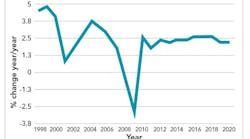State Of The Chemical Industry: Momentum Builds
During 2015, the worldwide manufacturing sector, which represents the primary customer base for the U.S. chemistry industry, continued to contend with market softness that started in 2014. However, U.S. chemical makers enjoyed competitive advantages due to shale gas. As a result, output of the U.S. chemical industry rose 3.6% last year — far better than the decline experienced in 2014 — and the prospects look bright for this year and beyond.
In the United States, the economy’s growth remains below its potential as high taxes, debt and regulatory burdens still take a toll on both business and consumer confidence. Companies have been cautious and capital spending was slow in 2015. Furthermore, overseas weakness and a higher dollar dampened U.S. exports. That said, further improvements in the employment situation, lower oil prices that are fostering more discretionary income, and asset prices moving higher are prompting consumers to start to spend again.
The U.S. economy should grow modestly this year. We can anticipate this by examining the trends in the Chemical Activity Barometer (CAB) of the American Chemistry Council (ACC). The CAB is a composite index of economic indicators that tracks the activity of the chemical industry. (The CAB appears each month in CP’s Economic Snapshot) Due to its early position in the supply chain, chemical industry activity leads that of the economy as a whole and, thus, the CAB can point to potential turning points in the overall economy. The CAB currently is signaling slow economic growth into 2016. The consensus forecast this year is for the U.S. gross domestic product (GDP) to grow 2.6%, which is slightly above trend (Figure 1). This should ease slightly in 2018 and beyond. As of December, the current recovery and expansion has lasted for 78 months; the average for post-World-War-II upturns is 60 months. So, the current upturn is getting a little old. Using a baseball metaphor, we are in the seventh inning. Long-term growth in the U.S. economy will moderate due to demographic, policy and other factors.
Figure 1. The GDP should grow at a modest level for the next several years.
Manufacturing output had improved in 2014 but activity stalled last year — marking the first year of this recovery and expansion in which industrial growth lagged that of the overall economy. This reflected a higher U.S. dollar, weak growth in emerging markets, rising uncertainty and lower gains in business investment, and the downturn in oil production. U.S. light vehicle sales did rise and should increase further in 2016 as pent-up demand, improving employment (and income) prospects, and better availability of credit foster growth. When all is said and done, 2015 and 2016 will represent the best years since 2000 for vehicle makers; sales should increase further for the next couple of years. However, the outlook for housing, the other large consumer of chemicals (about $15,000 per start), is still cautious. Interest rates are low and better job growth eventually will lead to improved household formations, the prime long-term driver for housing. Housing starts should increase in 2016 and 2017. Activity will remain well below the previous peak of 2.07 million units in 2005 but, by the second half of the decade, activity will approach the long-term underlying demand of 1.5 million units per year as suggested by demographics and replacement needs. Table 1 summarizes the macroeconomic outlook.
Industry Performance
As already noted, the volume of the U.S. chemical industry rose 3.6% in 2015. Even with the fall in oil prices, the U.S. chemical industry still has a favorable competitive position with regard to feedstock costs as natural gas prices have fallen as well. This will support U.S. chemical industry production going forward.
Softness in U.S. manufacturing has dampened domestic chemical demand and weakness elsewhere has hindered export sales although a favorable oil-to-gas price ratio normally would aid chemical exports. That said, U.S. exporters of plastic resins did very well in 2015. This is a preview of the long-term, as ACC expects trade in chemicals to continue to expand as global manufacturing activity improves and as additional U.S. capacity for organic chemicals, plastic resins and other downstream products comes onstream. However, imports of pharmaceuticals and agricultural chemicals still will spur trade deficits, which are partially offset by large (and growing) surpluses in basic and specialty chemicals.
The consensus is that U.S. chemical output will increase during 2016 and the second half of the decade (Table 2). Production should rise by 2.9% this year. Strong growth is expected in inorganic and organic chemicals, plastic resins and synthetic rubber as export markets revive and domestic end-use markets further improve.
Strong demand from end-use markets drove production of specialty chemicals into late-2014 but the collapse of drilling activity adversely affected the market for oilfield chemicals and the weakness in manufacturing hurt consumption in other segments. As a result, demand has been weak although exports took up some of the slack. In the long-term, production will improve as the manufacturing renaissance re-engages.
Table 1. Improvements in light vehicle sales and housing starts bode well for the chemical industry.
Strong 2015 gains in consumer products will moderate in 2016 and 2017. Demand for agricultural chemicals (and their supply from the U.S.) will revive. During the second half of the decade, the U.S. chemical industry likely will grow at a pace (over 4% per year on average) exceeding that of the overall U.S. economy. Aided by an aging population, pharmaceuticals eventually will emerge as a growth segment towards the end of the decade.
Although projected year-over-year growth rates for most segments appear strong over the next few years, they must be considered in the context of the exceptionally sharp declines seen in 2008 that continued into 2009.
Looking forward, the expected modest gains in chemical industry production volumes and stable capacity in most segments suggest improving operating rates; with strengthening production volumes, capacity utilization could improve even further this year and beyond.
Gas-Fueled Growth
Access to vast new supplies of natural gas has created an enormous competitive advantage for American chemical manufacturing, particularly for producing petrochemicals — and has driven significant expansion of existing capacity for petrochemicals. As a result, capital spending during 2014 surged 12.1% to $33.43 billion and likely increased 18.4% during 2015; it should rise more than 7% annually on average through 2018 with only a minor slowdown in growth after that. Expansions will continue and investments to improve operating efficiencies will play a role as well. By 2020, U.S. capital spending by the chemical industry will reach $55.3 billion — double the level of spending at the start of this prolonged cycle in 2009.
With high profit margins, a low cost of capital and the opportunities afforded by shale gas, prodigious increases in new plant and equipment investment in the U.S. should occur. Many petrochemical producers now consider the United States a favorable investment location and are embarking upon significant expansions of U.S. capacity, reversing a decade-long decline. Estimates place the gains to basic olefins capacity in the range of 35% to 40%. Indeed, companies have announced over 255 new chemical production projects (valued at over $158 billion altogether) through early December — and the dynamics for sustained capital investment are in place.
Access to plentiful and affordable natural gas supplies is allowing the United States to capture an increasing share of global chemical industry investment. This trend will continue as the United States has become a preferred location for investment.
While strength in American manufacturing, higher employment levels and growth in key end-use markets have translated into solid domestic demand for chemicals, weakness in external markets has limited U.S. chemical export sales. Despite the competitive boost the American chemical industry gets from a comparably favorable oil-to-gas price ratio, the large deficit in pharmaceuticals and agricultural chemicals will offset surpluses elsewhere.
Table 2. Growth in the industry’s production volume should outpace the rise in U.S. GDP from now through 2020.
Considering chemicals trade excluding pharmaceuticals, the U.S. is a net exporter. By this measure, the industry posted a trade surplus of $34 billion in 2015, reflecting a $30 billion surplus in basic chemicals. As new investments come online, growth in exports of basic chemicals will accelerate. Excluding pharmaceuticals, the surplus in chemicals trade should grow to $59 billion by 2020.
Good Signs
With the start of a new year, the U.S. chemical industry is building momentum. Continued recovery in end-use markets, a shift in competitiveness and the eventual return of global economic growth will lift demand for American chemicals over the next several years. Inventories remain somewhat balanced, so increasing demand for chemicals should come from new production rather than stock drawdowns. ACC expects to see above-trend growth in basic chemicals through 2020 in addition to solid demand in other segments.
Innovation also will continue to drive the American chemical industry, with growing investments in research and development in new molecules, new applications and new more-efficient processing techniques. Research into the safety of chemical products also remains a significant part of companies’ research programs.
With the development of shale gas and the surge in natural gas liquids supply, the United States has moved from being a high-cost producer of key petrochemicals and resins to among the lowest-cost producers globally. This shift in competitiveness is boosting export demand and driving significant flows of new capital investment toward the United States. We anticipate that recently announced new capacity for chemicals significantly will expand production when those investments come online beginning in 2016. As a result, employment in the chemical industry will pick up. The industry likely will add some net 35,000 high-paying jobs through the end of the decade. With the retiring of the baby boomers the need to attract and retain talent will be paramount. (For insights on what some chemical makers are doing to maintain their institutional knowledge and capture staff expertise, see: “Plants Grapple With Graying Staff.”)
THOMAS KEVIN SWIFT is chief economist and managing director of the American Chemistry Council, Washington, D. C. E-mail him at [email protected].





